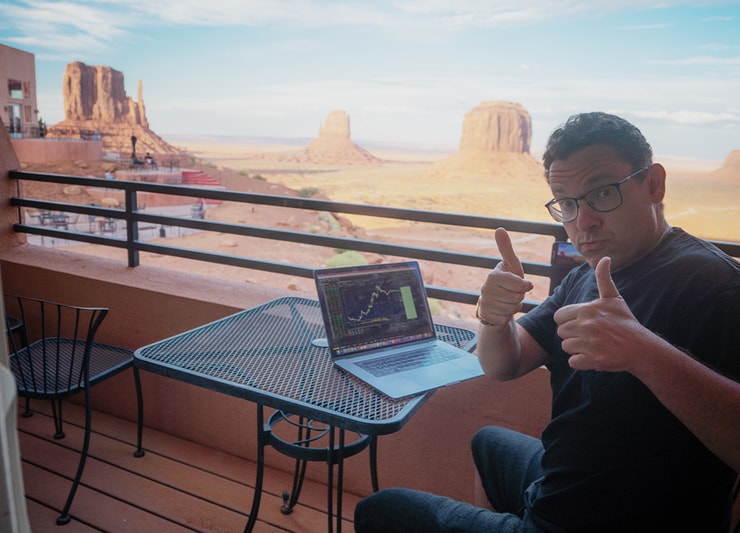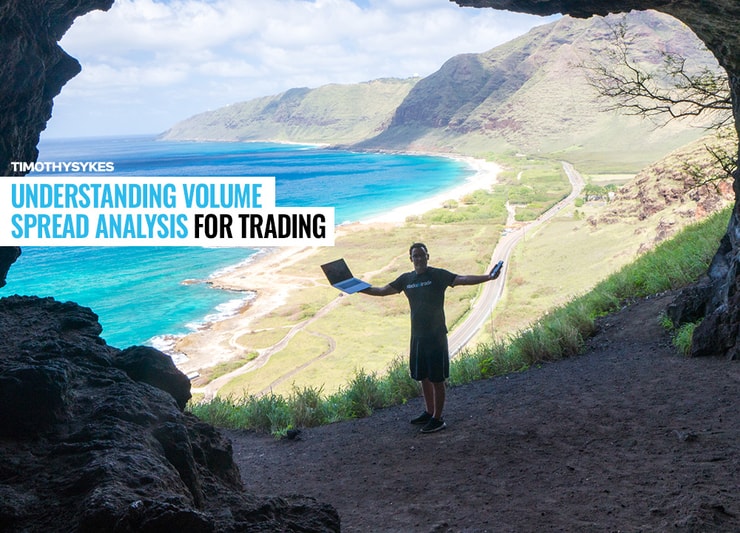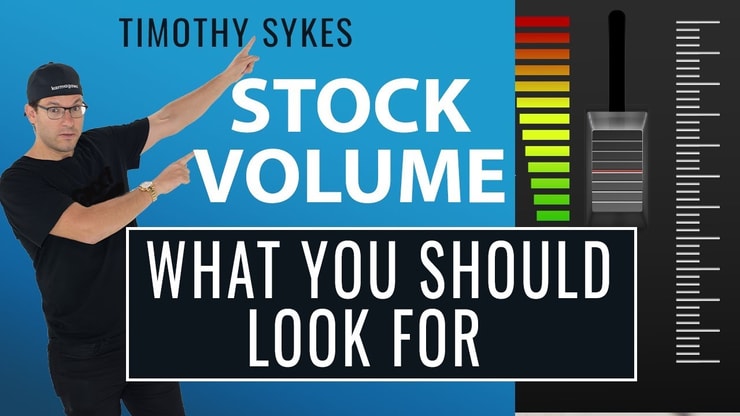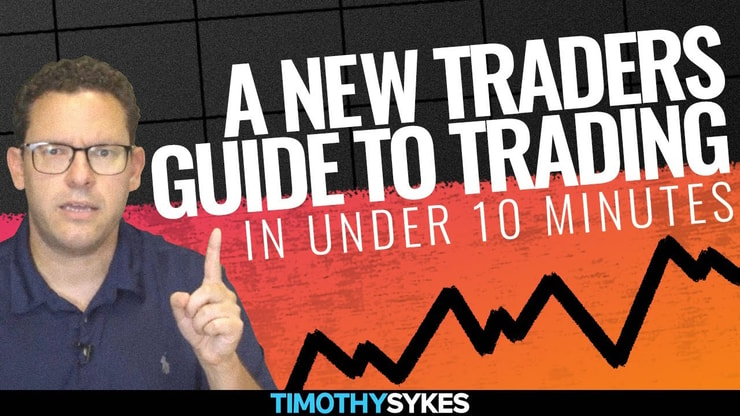Volume spread analysis (VSA) is a method of technical analysis that compares the volume per candle, range spread, and closing price to determine price direction. It involves interpreting stock charts to aid with trade setups.
There’s never ONE reason I buy a stock.
That’s important to remember … Volume spread analysis is an essential trading tool, but I have a few other tools in my arsenal that are just as essential.
For my whole trading checklist … click here.
Lucky for you, I share my whole process with other traders.
Most people in this niche are cold and shady. They hide shares and hold secrets.
I share ALL of my trades. And I share all of my trading patterns.
So far, over 30 of my students have used my patterns to profit over $1 million in the stock market.
Some of my students are way past that level. They’ve even made more than me! Jack Kellogg profited over $12.5 million. And he’s been trading for less than 5 years …
The secret’s out … I’m not the best trader. I’m a better teacher.
Want to learn about volume spread analysis? You came to the right place.
Table of Contents
What Is Volume Spread Analysis (VSA)?
Volume spread analysis is about analyzing the market’s supply and demand using volume and price bar data. Combined, the volume and price tell a story about the market.
It’s not just a theory; it’s a practical method used by traders to understand the market’s underlying pressures. Want to know if there are more buyers than sellers? Looking for clues in price action? VSA might be your answer.
This concept allows you to analyze the spread between prices and the volume of trades to gauge the market’s next move.
The Key Concepts of Volume Spread Analysis
Volume spread analysis isn’t a fleeting trend; it’s grounded in concepts developed by legends like Richard Wyckoff and later expanded by Tom Williams.
What’s the real scoop here? VSA integrates price action, closing price, and volume to discern the hidden movements of insiders, institutions, and seasoned investors. It’s like a window into a world where the balance of supply and demand reigns.
Two critical phases make this process tick: the accumulation phase and the distribution phase.
They’re not just terms; they’re the frame and structure of how markets ebb and flow. Do you want examples? Take a peek at Apple’s stock in various timeframes, and you’ll see these phases in action.
Your broker’s account probably offers tools that aid in this analysis, bridging the gap between esoteric theory and practical application.
However, professional traders route their broker through capable trading software.
Chances are, your broker’s website is displaying data 10 – 20 minutes late.
If the volume spikes that’s a sign a breakout could be coming soon. And I need to know that NOW. Not 10 or 20 minutes from now.
I helped create StocksToTrade so that it …
- Is compatible with key brokers
- Has up-to-date data
- Has every tool a small-account trader could want.
I used to need to open 7 different tabs just to make one trade. Now I just launch StocksToTrade.
>> Try a 14-day trial of StocksToTrade for $7 <<
Remember, this isn’t about a simple comparison between numbers. It’s a complex examination that requires understanding volumes, spreads, weaknesses, and even the psychological causes affecting the market.
Accumulation in Volume Spread Analysis

2025 Millionaire Media, LLCAccumulation is the phase where insiders and smart money participants are buying assets. It’s not about buying at the top; it’s about understanding the lows, the range, and where the market might rise next.
Accumulation is a stage in the market where supply and demand meet and volume analysis tells the tale.
Distribution in Volume Spread Analysis
Distribution is the opposite of accumulation. Here, the smart money is selling, and the weak are buying.
It’s the level where the market might turn from a bullish to a bearish trend. Understanding distribution isn’t about guessing; it’s about using volume and price data to sense the shift.
More Breaking News
- CorMedix Announces $85M Stock Offering Amid Strategic Expansion Plans
- Equinix Bounces Back: Projections and Possibilities
- Boeing’s Unforeseen Surge: What’s Fueling It?
Testing Supply in Volume Spread Analysis
When it comes to testing supply, VSA focuses on the selling pressure. Is there a lack of supply? Is the market moving sideways?
Analyzing volume and price together helps traders gauge the situation and make an informed trade.
Testing Demand in Volume Spread Analysis
Testing demand is the mirror image of testing supply. Here, traders are looking at the buying pressure and the amount of demand.
Using VSA, you can determine whether the market is in a bullish phase or if the demand is waning.
Understanding the Selling Climax in Volume Spread Analysis
The selling climax is not just a term; it’s a critical stage where the market reaches a bottom, and the smart money starts accumulating.
Understanding this phase requires attention to volume, spread, and price action. It’s a time when fear meets opportunity.
Applying Volume Spread Analysis Like a Professional

2025 Millionaire Media, LLCWant to walk in the shoes of professional traders? Volume spread analysis is the path.
It’s not just a method; it’s an approach packed with signals, tools, and techniques, reflecting the very fabric of the market world. Understanding the dynamics of spreads, phases, and how the accumulation and distribution stages work is vital.
Now, if you think this sounds complicated, don’t lose heart. Books, articles, and ample content are available to guide you.
Tom Williams’ works are one place to start, diving into how institutions and savvy investors operate. It’s about weaving information together, not in a whimsical way but forming a robust frame of analysis.
But if you think this niche is for you … there’s a better way to learn.
All of my millionaire students came from the Trading Challenge. I think it’s because …
- I share live trade recordings
- There’s a live chat with access to millionaire traders
- And the commitment helps people buckle down
Some people aren’t suited for trading. But if you’re drawn toward this industry …
>> Apply for the Trading Challenge <<
You’ll also need a broker with a suitable account.
But we’ll get to that later …
In conclusion, a well-calibrated system armed with VSA can be a huge asset. Just remember, every example, and every fact you gather, adds to your arsenal.
Spotting Volume Spread Analysis
Want to apply VSA like a pro? Spotting volume spread analysis means paying attention to the charts, bars, and candles. It’s about understanding the market’s pulse through volume and price.
How to Analyze Volume Activity in the Chart
Analyzing volume in the chart isn’t about randomly looking at bars and candles.
It’s a systematic approach where traders use technical indicators and chart patterns to gauge the market’s direction.
Trend Reversal After Selling Climax
The trend reversal after the selling climax is not an accident; it’s a result of understanding the market through VSA.
Here, traders look at the market’s lows, analyze the volume, and decide when it’s time to buy.
Time To Buy the Market After Test
Buying the market after a test is not a gamble; it’s a calculated move. Using VSA, traders analyze supply and demand, look at the trends, and decide when it’s time to make the trade.
Tools and Techniques in Volume Spread Analysis
VSA isn’t just a concept; it’s a set of tools and techniques that traders use every day.
Whether it’s analyzing tick volume, using specific indicators, or following methods like the Wyckoff method, VSA brings the charts to life. It’s not about guessing; it’s about applying proven techniques to your trading strategy.
That’s how professional traders find success.
Volume plays a crucial role in trading, offering insights into market direction and momentum. Understanding how volume interacts with price can be a game-changer in your trading strategy.
One essential aspect of volume analysis is the Volume-Weighted Average Price (VWAP), a benchmark used by traders to gauge market direction. It combines both volume and price to provide a more accurate picture of the market’s trend.
If you’re looking to deepen your understanding of volume in trading, explore this guide on how to use VWAP to enhance your trading decisions.
Does VSA Function in All Markets?
VSA isn’t limited to one market or trading style. Whether it’s forex trading, stocks, or other assets, VSA functions across markets. But it’s not a one-size-fits-all approach; it’s a versatile technique that traders can apply to various situations.
Relative volume is a vital indicator that compares current volume to past trading volumes, providing insights into the strength or weakness of a trend. It’s a versatile tool that can be applied across various markets, including stocks and forex.
By understanding how relative volume works, traders can better gauge the significance of price movements and make more informed decisions.
If you’re interested in leveraging relative volume in your trading strategy, here’s a comprehensive guide on relative volume trading that can help you navigate the complexities of the market.
Understanding Candles in Volume Spread Analysis

2025 Millionaire Media, LLCEver wonder how candlesticks fit into the puzzle of volume spread analysis? These aren’t mere visual aids; they’re a narrative of market psychology, telling tales of investors’ fear, excitement, and even weakness.
Each candle represents a specific timeframe, painting a picture of the market’s heartbeat.
Drawing from Richard Wyckoff’s principles, the understanding of candles in VSA is more than just aesthetics. It’s about deciphering the information hidden in the spreads, closing price, and volume.
Quantity matters, but so does quality, and that’s where the art of reading candlesticks comes into play.
Candlestick patterns are more than just visual aids; they tell a story of market psychology and investor behavior. One such pattern is the shooting star candle, a bearish reversal pattern that can signal the end of an uptrend.
Recognizing these patterns can provide valuable insights into potential market reversals and opportunities for profit.
If you’re looking to enhance your trading strategies with the knowledge of candlestick patterns, discover the intricacies of the shooting star candle and how it can be a valuable tool in your trading toolkit.
Rules To Construct Trends Channels
Constructing trend channels using candles isn’t a random act; it’s governed by rules.
Understanding these rules helps traders identify overbought and oversold levels and make informed trades.
Using Trend Line To Determine Overbought and Oversold Levels
Using trend lines in VSA helps traders determine critical levels. It’s not about hunches; it’s about analyzing the market’s actions and making informed decisions.
Analyzing Volume Near a Trend Line
Volume near a trend line isn’t just a random fluctuation; it’s a signal. Understanding this volume helps traders gauge the market’s direction and make the right moves.
Absorption Volume and Lower Trend Line
Absorption volume and the lower trend line are key concepts in VSA.
Understanding these helps traders gauge the market’s sentiment and make trades accordingly.
Key Takeaways

2025 Millionaire Media, LLCThe key takeaways from volume spread analysis are not just concepts or theories; they are practical insights that traders can apply.
From understanding accumulation and distribution to spotting trends and making trades, VSA offers a versatile approach for traders across markets.
It isn’t a silver bullet for your trading plan — but VSA is one of many topics you should learn as part of your trading education!
Trading isn’t rocket science. It’s a skill you build and work on like any other. Trading has changed my life, and I think this way of life should be open to more people…
I’ve built my Trading Challenge to pass on the things I had to learn for myself. It’s the kind of community that I wish I had when I was starting out.
We don’t accept everyone. If you’re up for the challenge — I want to hear from you.
Apply to the Trading Challenge here.
Trading is a battlefield. The more knowledge you have, the better prepared you’ll be.
Do you use volume spread analysis in your trading strategy? Let me know in the comments — I love hearing from my readers!
FAQs
How Different Is Volume Spread Analysis from the Wyckoff Method?
Volume spread analysis and the Wyckoff Method are connected but different. While both focus on volume and price, VSA is a specific approach that offers unique insights.
The difference lies in the techniques, indicators, and application.
Can Volume Spread Analysis be Used for Swing Trading?
Yes, volume spread analysis can be used for swing trading. It’s not limited to day trading or long-term investments; it’s a versatile approach that can be applied across different trading styles.
Is There a Specific Volume Spread Analysis Strategy for Day Trading?
Volume spread analysis (VSA) can be tailored for day trading. It’s not a rigid method; it’s a system that traders can adapt to fit their trading style, whether it’s day trading, swing trading, or others.
Understanding VSA offers flexibility and insight, making it a valuable addition to any trading toolkit.
How Does Volume Price Analysis Impact People in Different Trading Areas?
Volume price analysis (VPA) is one of those things that can seem mysterious at first glance, but it plays a crucial role in various trading areas.
Whether you’re a day trader in stocks or diving into the complex world of forex, understanding VPA can be a game-changer.
In essence, VPA offers a deeper insight into market movements by evaluating the connection between trading volume and price changes.
For those involved in different trading areas, this understanding can provide an edge in predicting future market directions and making informed decisions.











Leave a reply